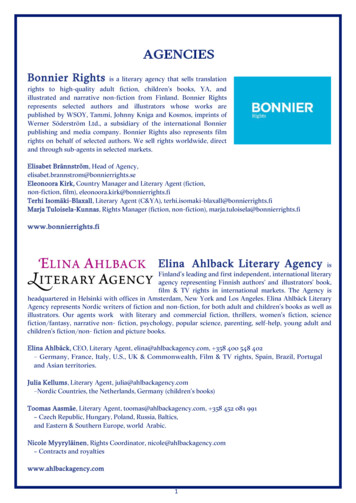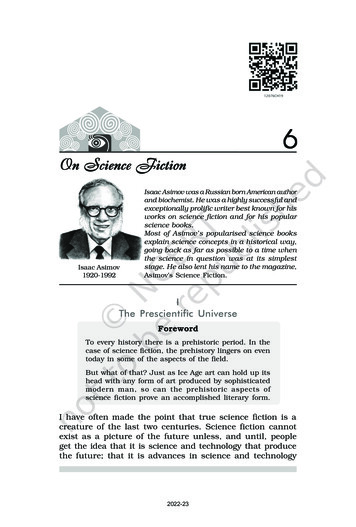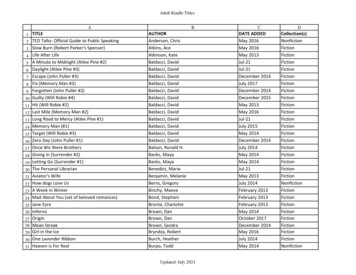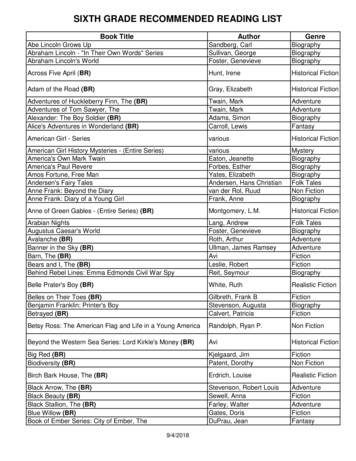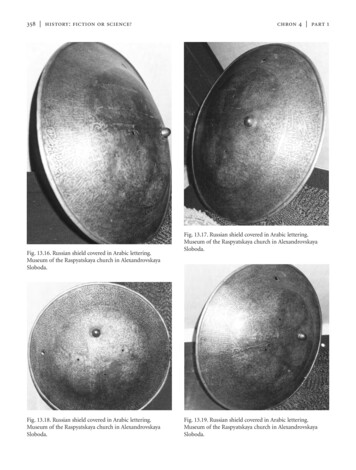
Transcription
358 history: fiction or science?Fig. 13.16. Russian shield covered in Arabic lettering.Museum of the Raspyatskaya church in AlexandrovskayaSloboda.Fig. 13.18. Russian shield covered in Arabic lettering.Museum of the Raspyatskaya church in AlexandrovskayaSloboda.chron 4 part 1Fig. 13.17. Russian shield covered in Arabic lettering.Museum of the Raspyatskaya church in AlexandrovskayaSloboda.Fig. 13.19. Russian shield covered in Arabic lettering.Museum of the Raspyatskaya church in AlexandrovskayaSloboda.
chapter 13old russia as a bilingual state 359Fig. 13.20. Russian shield covered in Arabic lettering.Museum of the Raspyatskaya church in AlexandrovskayaSloboda.Fig. 13.20b. Ancient armaments of a Russian warrior in themuseum of Kolomenskoye in Moscow. Chain mail, mace,helmet etc. Photograph taken by the authors in June 2001.Fig. 13.20a. One of the two shields exhibited in the museumof Kolomenskoye in Moscow. According to the explanatoryplaque, the helmet was made in Russia; however, the plaquedoesn’t say a single word about the Arabic lettering presenton the helmet. It is visible well on the photograph (wide stripat the bottom). The photograph was taken by the authors inJune 2001.Fig. 13.20c. Close-in of the second Russian helmet in themuseum of Kolomenskoye. The lettering on the helmet isnon-Cyrillic – possibly, Arabic. It has to be pointed out thatthere is a distinctly visible swastika on the helmet.Photograph taken by the authors in June 2001.
360 history: fiction or science?chron 4 part 1Fig. 13.22. Fragment of Alexander Nevskiy’s helmet (“Jerichohat?”) with Arabic lettering.Fig. 13.21. Helmet of Alexander Nevskiy (“Jericho hat?”).According to the historians themselves, the lettering on thehelmet is Arabic. From a copy of “Antiquités de l’empireRusse, édités par orde de Sa Majesté l’empereur Nicolas I”kept in the public royal library of Dresden, Germany. Thephotograph that we reproduce here was taken from the coverof the “Russkiy Dom” magazine, issue 7, 2000. The legendnext to the helmet says “760 years of the Battle of Neva”. Asmall photograph of this helmet was also reproduced in thearticle about Alexander Nevskiy. However, historians eventually “recollected” that the helmet in question dates from theepoch of the Muscovite Czars of the XVI-XVII century. Seealso [336], Volume 5, inset between pages 462 and 463.Fig. 13.23. Close-in of a fragment of Alexander Nevskiy’shelmet.another example – the famous helmet of AlexanderNevskiy. We haven’t managed to find it anywhere during our visit to the armoury in 1998 (alternatively, itmay identify as the abovementioned “Jericho Hat”).It is also possible that it had been removed from exposition temporarily; however, we do not find it inthe famous fundamental album entitled The StateArmoury ([187]). We haven’t managed to find it inany of the other accessible albums on the museumsand history of the Kremlin in Moscow. We have accidentally come across a drawing of Alexander Nev-skiy’s helmet in a rather rare multi-volume edition entitled History of Humanity. Global History ([336],published in Germany and dating from the end of theXIX century). We have then found a photograph ofthis helmet in the “Russkiy Dom” magazine (issue 7,2000). We reproduce it in fig. 13.21; it turns out thatthere’s an Arabic inscription upon the helmet of Alexander Nevskiy (figs. 13.22 and 13.23). The commentary of the German professors is as follows: “Helmet of Great Prince Alexander Nevskiy, made of redcopper and decorated with Arabic lettering. Made in
chapter 13Asia and dates from the crusade epoch. Nowadays inthe possession of the Kremlin in Moscow” ([336],Volume 5, pages 462-463, reverse of the inset).There is indeed an Arabic inscription at the verytop of the helmet, which resembles the “Jericho Hat”of Mikhail Fyodorovich to a great extent (the inlayslook silver and not golden in this photograph,though). One might enquire about the possibility ofAlexander Nevskiy’s helmet being the very same as the“Jericho Hat” – identified as the former in the XIXcentury and presumed to be the latter by the historians of today, much to their confusion. Could both options be true simultaneously? We shall be telling moreabout this hypothesis of ours in Chron6.Thus, the German historians of the late XIX century, likewise modern Russian historians, suggest theRussian weapons and armour decorated by Arabicinscriptions to have been made somewhere in theOrient, and definitely not in Russia. Russian warriorspresumably purchased or received them as presentsfrom the Arabs. Only in a number of cases do learnedhistorians admit that the “Arabic weapons” wereforged by the Russian craftsmen, including thoseworking for the State Armoury of Moscow ([187]).Our reconstruction paints an altogether differentpicture. Several alphabets had existed in Russia untilthe XVII century, the one considered Arabic nowadays being one of them. The alphabet considered exclusively Arabic today and associated with the MiddleEast had also been used for Russian words. Mass production of the ancient Russian weapons could onlyhave taken place in Russia, or the Horde; all the inscriptions found upon these weapons were made byRussian craftsmen who had used Arabic script alongside, or in lieu of, the Cyrillic script that is considered“more Slavic” nowadays.Modern historians are trying to convince us thatthe “mediaeval Arabs” all but drowned Russia in Arabic weapons and armour, which would be proudlywielded and word by the Russian soldiers who did notunderstand the meaning of the sophisticated Arabicinscriptions decorating their weapons, and so theyfought and died accompanied by prayers and religious formulae of the “faraway Muslim Orient”. Webelieve this to be utter nonsense – Russian warriorsof that epoch had been perfectly capable of understanding that which was written upon their weaponsold russia as a bilingual state 361and armour due to the fact that several alphabets andlanguages had been used in the pre-XVII centuryRussia, including the precursor of the modern Arabic.It would make sense to confront the historians oftoday with the following issue. The manufacture of“Arabic” weapons in such enormous amounts musthave left numerous traces in Arabia, whence they hadpresumably been imported en masse by the Russiansin the Middle Ages. There are none such – we knownothing of any blast furnaces, smelting facilities orlarge-scale weapon manufacture in the deserts of mediaeval Arabia. The reverse is true for Russia – it suffices to recollect the Ural with its reserves of ore, numerous blast furnaces, weapon manufacturers etc.We know of many Russian towns and cities that hadproduced heavy armaments in the XIV-XVI century– Tula and Zlatoust, for instance. Therefore, it is mostlikely that the weapons decorated by “Arabic” inscriptions were manufactured in mediaeval Russia.It becomes instantly clear that the famous “Arabicconquest” that had swept over a great many countriesin the Middle Ages is but a reflection of the same oldGreat “Mongolian” conquest that had made vast territories in Eurasia, Africa and America part of theRussian Empire, also known as the Horde. The word“Arab” might be derived from the word “Horde”(“Orda” in Russian), considering that the Romaniccharacters for “b” and “d” would often be confusedfor one another; as we shall demonstrate in Chron5,the orientation of the two letters had still been vaguein the Middle Ages, they could easily become reversed.Linguistic considerations of this kind are by no meansa proof of anything on their own; however, they doconcur with our reconstruction quite well.As we were “explained” by the staff of the State Armoury in 1998, the “Arabic” blades for the Russianweapons were forged by the Arabs in faraway Spainand Arabia (later also Turkey). However, the handleswere all made locally, in Russia. However, the following fact contradicts this “theory” in a very obvious manner. As we mentioned above, the Armouryhas got the sabre of F. I. Mstislavskiy, up for exhibition. This is how it is described by the modern historians: “The big sabre had belonged to F. I. Mstislavskiy as well; this is confirmed by the Russian lettering on the back of the blade. The blade is decoratedby golden inlays with Arabic lettering; one of the in-
362 history: fiction or science?chron 4 part 1scriptions translates “Willserve in battle as strong defence” ([187], page 207).However, the commentary of the learned historiansdoesn’t give us the full picture – the inscription on theback of the blade is simplymentioned and left at that.We saw this sabre in 1998 –the name of the owner inRussian isn’t a mere engraving; it was cast in metal at thevery moment the blade wasmanufactured, by the smithswho had made it (“Arabs”from the faraway Orient, aswe are told today). However,we are of the opinion that the Fig. 13.24. Helmet of Ivan the Terrible. XVI century. Royal Museum of Stockholm. We seename of Mstislavskiy, the a wide strip with Arabic lettering, with a narrower strip with Russian lettering underRussian warlord, was set in neath. Taken from [331], Volume 1, page 131.Russian lettering by Russiancraftsmen – the same onesthat made the golden inlaid pattern with the Arabic2.inscription on the blade, in full awareness of its meanARABIC TEXT UPON THE RUSSIAN MITRE OFing (“Will serve in battle as strong defence”, qv above).PRINCES MSTISLAVSKIYSome of these “Arabic” armaments have beenmade in Turkey, or Ottomania, which had been partThe Troitse-Sergiyev Monastery in the town ofof Russia (or the Horde) up until the XVI century.Sergiyev Posad (Zagorsk) houses the museum of theIn fig. 13.24 we see the helmet of Ivan the TerribleOld Russian decorative art. Among the items exhibkept in the Royal Museum of Stockholm ([331], Volited in the museum we find the “Mitre fating fromume 1, page 131). It is decorated by inscriptions in1626. Gold, silver, gemstones and pearls; enamel, inlaypatterns, engraving. Donated by the Princes Mstitwo scripts – Cyrillic and Arabic, the latter being ofslavskiy” (see fig. 13.25).a larger size and situated on top of the Russian letA photograph of the mitre can be found in thetering.album compiled by L. M. Spirina and entitled TheIt is unclear why the representatives of historicalTreasures of the State Museum of Art and History inscience cite the entire Russian inscription in [331] asSergiyev Posad ([809]).they tell us about the helmet of Ivan the Terrible, butWe visited this museum in 1997 and discovered anwithhold from citing its neighbour set in Arabicinteresting fact. There is a large red gem in the frontscript.part of the mitre, right over the golden cross. ThisIn Chron7, Annex 2 we cite a number of exclusivegemstone has an Arabic inscription carved into it;materials, namely, the inventory of the ancient Rusthis inscription is rather hard to notice, since one hassian weapons stored in the State Armoury of theto look at the mitre from a certain angle – otherwiseKremlin in Moscow. This inventory demonstrates thatit is rendered invisible by the shining of the stone. Wethe inscriptions found upon Russian weapons andasked the guide about the Arabic lettering as soon asconsidered Arabic today are typical and not a merewe noticed it. The guide confirmed the existence ofnumber of rare exceptions.
chapter 13old russia as a bilingual state 3633.THE WORD “ALLAH” AS USED BY THERUSSIAN CHURCH IN THE XVI AND EVEN THEXVII CENTURY, ALONGSIDE THE QUOTATIONSFROM THE KORAN3.1. “The Voyage beyond the Three Seas” byAfanasiy NikitinWe have already pointed out the fact that manyRussian weapons, as well as the ceremonial attire ofthe Russian Czars and even the mediaeval mitre of aRussian bishop are all adorned by Arabic inscriptions, some of which can be identified as passagesfrom the Koran (see Chron4, Chapters 13:1-2). ThisFig. 13.25. Mitre of 1626. A donation made by the Russianprinces of Mstislavskiy. We see a large gemstone in front withArabic lettering carved upon it. Taken from [809].an Arabic inscription carved into the stone; however,nobody in the museum knew anything about the possible translation.Once again we encounter Arabic script upon anOld Russian artefact. The fact that the inscription inquestion is in the front of the mitre, right over thecross, or on the very forehead of whoever had wornthe mitre, clearly testifies to the fact that the inscription is anything but arbitrary, and must have had anexplicit meaning in the epoch of the mitre’s creation.Let us cite the famous “Kazan Hat” as another example of the fact that the so-called “Oriental” styleis really the mediaeval Russian style originating fromthe very heart of the Russian Empire, formerly knownas the Horde. It is a luxurious royal headpiece thatlooks “distinctly Oriental”; however, it had beenmade for Ivan the Terrible by Muscovite craftsmen(see fig. 13.26).Fig. 13.26. The Kazan Hat (ceremonial headdress of Ivan theTerrible). Armaments Chamber, Moscow. Presumed to bemade in Russia “with the assistance of Oriental craftsmen”([187], pages 386-387). The presumption about the participation of the “Oriental craftsmen” stems from the fact thatthe modern commentators fail to understand that the“Oriental style” is simply the old Russian style of the XV-XVIcentury. Its origins are purely Russian; it wound up in theOrient during the Great “Mongolian” conquest of the XIVXV century. Taken from [187], page 346.
conquest"that had swept over a great many countries in the Middle Ages is but a reflection of the same old Great "Mongolian"conquest that had made vast ter-ritories in Eurasia, Africa and America part of the Russian Empire, also known as the Horde. The word "Arab" might be derived from the word "Horde"

